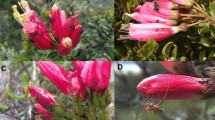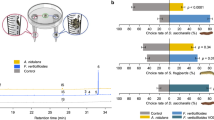Abstract
INSECTS can effect sexual reproduction in some plant pathogens, such as the rust fungi, by carrying spermatia (gametes) between different mating types1–5. This function of insects is analogous to their role as pollinators of plants, and contrasts with their more widely known5–9 role as vectors of plant pathogens' infectious spores. Here I report an extraordinary case of pathogen-mediated floral mimicry that contributes to fungal reproduction. The rust fungus Puccinia monoica inhibits flowering in its host plants (Arabis species) and radically transforms host morphology, creating elevated clusters of infected leaves that mimic true flowers of unrelated species in shape, size, colour and nectar production. These fungal pseudoflowers attract insects which fertilize the rust. Because the pseudoflowers are highly successful in attracting pollinating insects, they may also affect the reproductive success of nearby flowering plants.
This is a preview of subscription content, access via your institution
Access options
Subscribe to this journal
Receive 51 print issues and online access
$199.00 per year
only $3.90 per issue
Buy this article
- Purchase on Springer Link
- Instant access to full article PDF
Prices may be subject to local taxes which are calculated during checkout
Similar content being viewed by others
References
Craigie, J. H. Nature 120, 765–767 (1927).
Buller, A. H. R. Researches on Fungi, Vol. VII, The Sexual Process in the Uredinales (University of Toronto, Toronto, 1950).
Petersen, R. H. Bot. Rev. 40, 453–513 (1974).
Savile, D. B. O. in Evolutionary Biology (eds Hecht, M. K., Steere, W. C. & Wallace, B.) 137–205 (Plenum, New York, 1976).
Webber, J. F. & Gibbs, J. N. in Insect-Fungus Interactions (eds Wilding, N., Collins, N. M., Hammond, P. M. & Weber, J. F.) 161–189 (Academic, London, 1989).
Jennersten, O. Oikos 40, 125–130 (1983).
Batra, L. R. & Batra, S. W. T. Science 228, 1011–1013 (1985).
Alexander, H. M. & Antonovics, J. J. Ecol. 76, 91–104 (1988).
Alexander, H. M. & Maltby, A. Oecologia 84, 249–253 (1990).
Index of Plant Diseases in the United States (US Department of Agriculture, Washington DC, 1960).
Farr, D. F., Bills, G. F., Chamuris, G. P. & Rossman, A. Y. Fungi on Plants and Plant Products in the United States (American Phytopathological Society, St Paul, Minnesota, 1989).
Pleasants, J. M. Ecology 62, 1648–1661 (1981).
Watt, W. B., Hoch, P. C. & Mills, S. G. Oecologia 14, 353–374 (1974).
Kevan, P. G. in Handbook of Experimental Pollination Biology (eds Jones, C. E. & Little, R. J.) 3–30 (Van Nostrand Reinhold, New York, 1983).
Baker, H. G. & Hurd, P. D. A. Rev. Entomol. 13, 385–414 (1968).
Weiss, M. R. Nature 354, 227–229 (1991).
Craigie, J. H. Phytopathology 21, 1001–1040 (1931).
Stanton, M. & Galen, C. Oecologia 78, 477–485 (1989).
Kearns, C. A. thesis, Univ. Maryland (1990).
Van der Plank, J. E. Principles of Plant Infection (Academic, New York, 1975).
Feinsinger, P. Trends Evol. Ecol. 2, 123–126 (1987).
Waser, N. M. in Handbook of Experimental Pollination Biology (eds Jones, C. E. & Little, R. J.) 277–292 (Van Nostrand Reinhold, New York, 1983).
Campbell, D. R. & Motten, A. F. Ecology 66, 554–563 (1985).
Roy, B. A. thesis, Claremont Graduate School (1992).
McIntosh, R. A. & Watson, I. A. in The Rust Fungi (eds Scott, K. J. & Chakravorty, A. K.) 121–149 (Academic, London, 1982).
Agrios, G. N. Plant Pathology (Academic, San Diego, California, 1988).
Alexander, H. M. in Plant Resistance to Herbivores and Pathogens: Ecology, Evolution, and Genetics (eds Fritz, R. S. & Simms, E. L.) 326–344 (University of Chicago Press, Chicago, 1992).
Sokal, R. R. & Rohlf, F. J. Biometry (Freeman, New York, 1981).
Smith, I. Chromatographic and Electrophoretic Techniques, Vol. 1, Chromatography (Pitman, Bath, 1969).
Cummins, G. B. & Hiratsuka, Y. Illustrated Genera of Rust Fungi (American Phytopathological Society, St Paul, Minnesota, 1983).
Author information
Authors and Affiliations
Rights and permissions
About this article
Cite this article
Roy, B. Floral mimicry by a plant pathogen. Nature 362, 56–58 (1993). https://doi.org/10.1038/362056a0
Received:
Accepted:
Published:
Issue Date:
DOI: https://doi.org/10.1038/362056a0
This article is cited by
-
Everybody Lies: Deception Levels in Various Domains of Life
Biosemiotics (2022)
-
Insect herbivory facilitates the establishment of an invasive plant pathogen
ISME Communications (2021)
-
Spore Dispersal of Fetid Lysurus mokusin by Feces of Mycophagous Insects
Journal of Chemical Ecology (2014)
-
The Microbial Olympics
Nature Reviews Microbiology (2012)
-
Moths that Vector a Plant Pathogen also Transport Endophytic Fungi and Mycoparasitic Antagonists
Microbial Ecology (2008)
Comments
By submitting a comment you agree to abide by our Terms and Community Guidelines. If you find something abusive or that does not comply with our terms or guidelines please flag it as inappropriate.



